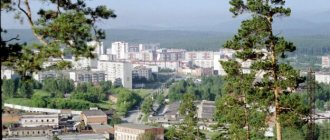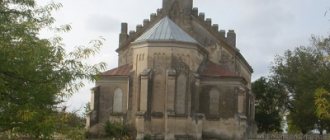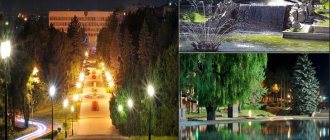Year founded: 1773
At the entrance to the city
Miass city
is a Russian city of regional significance in the Chelyabinsk region, located 96 km southwest of Chelyabinsk. Located on the eastern slope of the Southern Urals, at the foot of the Ilmen Mountains, on the Miass River. The distance from Miass to Moscow is 2000 km. Territorial region – Southern Urals. The main river is the Miass, the right tributary of the Iset River, the Irtysh basin.
Miass was founded on November 18, 1773
in connection with the founding of a copper smelter on the basis of the Miass copper ore deposit discovered in 1754.
In 1797, the first gold deposit was discovered on the Tashkuturganka River, the left tributary of the Bolshoi Iremel, near the Miass plant, and in the 1820s, the richest gold placers in the Urals were discovered in the valley of the Miass River - the average annual gold production at the Miass mines was about 40 pounds . One of the world’s largest gold nuggets, the “Big Triangle,” weighing 36.2 kg, was found here.
Miass is located on the river that gave the city its name. By the middle of the 19th century, Miass was experiencing a period of growth: crafts and trade were developing. By the end of the 19th century, due to the construction of the Zlatoust-Chelyabinsk and Chelyabinsk-Ekaterinburg railway and a slight decrease in gold mining, the growth of Miass slowed down, however, at that time the population in Miass exceeded the population of Chelyabinsk.
City
Miass became a city in 1926. Further development was associated with the construction in 1941 of a motor vehicle with equipment evacuated from Moscow during the Great Patriotic War.
In modern Miass, the Ural Automobile Plant is the largest enterprise. Since 1959, the construction of large defense enterprises began at the Design Bureau of Mechanical Engineering (now the State Missile Center, the V.P. Makeev Design Bureau and the Miass Machine-Building Plant) and the Electromechanical Institute (now the NPO Elektromekhanika). Their construction gave impetus to the development of a large residential area in the northern part of the city.
Ilmensky Reserve
In the old part of the city there is an orthogonal regular layout of the late 18th century; a large pond with a dam divides it into “zones.” The buildings are dominated by wooden houses from the 19th and early 20th centuries with balconies and carved architraves. New residential areas emerging in the area of the automobile plant and the northern part of the city (Mashgorodok) are being built up with high-rise buildings while preserving forest areas in the layout.
Around
Miass is home to industrial mining of gold, talc, marble, limestone and granite.
Near the city is the Ilmensky Nature Reserve, founded in 1920 as a mineralogical reserve. The Ilmensky Nature Reserve is a unique place in the world, where several hundred varieties of minerals are concentrated in an area measuring 35 by 25 kilometers. Around the globe, 2,500 minerals have now been studied.
Lake Turgoyak - the cleanest lake in the Urals
Geologists around the world call the “Ilmen Pantry” a mineralogical paradise. The Mineralogical Museum of the reserve, founded in 1930, is known throughout the world. In terms of area, the Ilmensky Reserve ranks 34th among the country's reserves (out of 130 reserves in Russia).
Landmark
The area also includes Lake Turgoyak, a closed lake of tectonic origin, located in an intermountain basin. It is fenced by the Ural-Tau ridges in the west and the Ilmensky ridge in the east. This is one of the most picturesque lakes in the Urals. It is included in the list of the most valuable reservoirs in the world. Turgoyak is a repository of the purest drinking water, the quality of which is not inferior to that of Baikal.
The population of the city is more than 150 thousand people (2014).
Day of the city
Miass celebrates in the fall.
General information and history of the city
When Pugachev and his army reached the Ural Mountains and needed a place to stay, he sent two warriors, a Russian and a Bashkir, to reconnaissance.
They returned with good news - there is a clean river nearby. When Pugachev asked who was the first to see the river, the Bashkir said: Mi (I - in Bashkir), the Russian replied: Ya-ss. So they called her Miyass. And then they gradually began to say the more familiar Miass for us. This is one of the legends about the origin of the name of the river and the city that stands on it. There are other, more scientific, but less poetic explanations.
Miass
Officially, Miass dates its history back to 1773, when copper smelting appeared here. In 1897, a large gold deposit was discovered in Miass, which immediately gave a new impetus to the development of the settlement. Gold is sought and found here today. Since 1926, Miass has been part of the Chelyabinsk region. During the war, an automobile plant was evacuated here. In 1982, Miass was awarded the Order of the Red Banner of Labor and was given the status of a historical settlement.
The total area of the city is 111.9 thousand square kilometers. Time zone – plus 5 hours Greenwich Mean Time, plus 2 hours Moscow time. The coat of arms of Miass shows an elk with inclined antlers.
Ecology and climate of Miass
The Golden Valley in which Miass is located is called Ural Switzerland. The most beautiful time is early autumn, when the mixed forests of the slopes of the Ural Mountains give an amazing picture: birch trees turn yellow and against the backdrop of evergreen pines they look like a leopard skin. This is a country of mountains and lakes.
Turgoyak is the pearl of the Urals, the second cleanest lake in Russia, after Baikal. The area of the lake is 26.4 sq. km, the length of the coastline is 27 km. Endorheic lake of tectonic origin. Radon springs make its water not only clean, but also cold. But there are plenty of warmer lakes around: Ilmen, Kisegach, Inyshka, Terenkul, Elovoe, Kusykul, Argazi.
Turgoyak
The Ilmensky State Nature Reserve is located in the Miass urban district, which already says a lot about the ecology of the city and the region. Almost the only air polluter is the Ural Automobile Plant, one of the city's city-forming enterprises. But it clearly cannot cope with the task of pollution.
Automobile plant
Clean mountain air, filled with the aroma of pine forests, makes this place a real resort, albeit with somewhat harsh weather. The climate is temperate continental. The average temperature in winter is minus 15, although there are frosts of 35. The average summer temperature is plus 20, although in recent years the summer has become warmer and warmer; the heat can remain over 30 degrees for a week or two.
The main environmental problem is the littering of lake shores by tourists. A series of environmental raids are usually carried out in May and September to clear the coastal strip of debris, but the problem remains.
On the shores of the lake you can find something different
Miass
Miass can rightfully be called a treasury of all the riches of the generous Ural nature. For centuries, people wrote poems about the Golden Valley, surrounded the pearl of the Southern Urals - Lake Turgoyak - with legends, and sang the wisdom imprinted in the Ilmen stone placers.
Here, where the mountains are closed in a ring and their coniferous peaks are reflected in the water surface of the blue lakes, a copper smelter was built in 1773. A settlement formed around it, outbuildings were erected, streets appeared, temporary residential buildings were replaced by houses.
The economic development of Miass was facilitated by the development of gold deposits. In the first half of the 19th century, the entire valley of the Miass River turned into a huge gold mine. In 1836, 54 mines and 23 gold deposits were being developed in our area. It was here that one of the world’s largest nuggets, the “Big Triangle”, weighing 36 kg, was found, which is today stored in the Russian diamond fund. Gold mining remained the main city-forming industry until the beginning of the 20th century.
The modern glory of the city was brought to it by the famous AMO-ZIS, evacuated during the Great Patriotic War - the current automobile manufacturer, which produces heavy-duty off-road vehicles. Miass "Urals" have proven themselves in the conditions of the far north, and in the southern deserts, and in difficult extreme conditions.
In the 20th century, Miass earned a reputation as one of the major engineering and technical centers, thanks to the machine-building factories located here and the state missile center named after Academician Viktor Petrovich Makeev.
It was our city back in 1955 that was destined to become a powerful experimental base for rocket science. Complex engineering tasks required high qualifications; first-class specialists from all over the country came to Miass. To improve their life in the new area, residential buildings, shops, schools, and kindergartens were built. The strictest secrecy regime did not allow references to the name of the city. Mashgorodok - this is how the location of the enterprise was designated. For the construction of this part of the city while preserving the natural landscape, a group of architects received a State Prize.
Today, the Research and Production Association of Electromechanics is the only Russian developer and manufacturer of gyroscopic devices for control systems of rocket and space technology for various purposes: for the Soyuz-2 launch vehicle, anti-ship cruise missiles Yakhont, BrahMos, for OTRK "Iskander". Miass is proud of its records. In the new century, our city even found itself in the famous Guinness Book of Records thanks to the park of giant stationery figures. Scissors, a paper clip, compasses and other measuring instruments and stationery enlarged tenfold, seem to exaggerate the intellectual feat of Miass engineers and rocket scientists during the times of world space discoveries and nuclear arms races. Previously, the proud title of “the largest paper clip on the planet” belonged to a monument erected in the capital of Norway, Oslo. Our craftsmen built their copy almost 4 meters higher than the Scandinavian one.
Over the past decade, thanks to the efforts of small businesses, Miass has become a kind of furniture capital of Russia, producing interior items for every taste: from kitchens to magnificent bedrooms in the Italian style. Back in the perestroika eighties, she set herself an ambitious task: to introduce style and variety into the standard “boxes” of Miass apartments. And now individuality and originality are the main principles of LORENA Kitchen’s activities. Each headset of the company is an original work.
One of the modern enterprises in the Russian automotive industry is located in Miass. This is a joint Russian-Italian company that produces heavy-duty vehicles adapted to work in difficult road and climatic conditions.
The leading position in Russia in the field of mechanical engineering today is occupied by a modern company that is continuously developing new models of special equipment together with customer enterprises.
The Miass research and development center, which is developing a number of different devices and identification systems for law enforcement agencies, based on modern biometric solutions, is of particular note throughout the country. Today, the company’s track record includes a number of successfully implemented projects at the regional and federal levels. Getting to know the city often begins with the Ilmensky Nature Reserve. This is the rarest and richest geological treasure trove of the Urals. The main wealth of Ilmen is its minerals, of which there are over 260 species in the mineralogical museum.
The main wealth of Miass are its unique lakes. Turgoyak is included in the list of the most valuable reservoirs in the world. The quality of the water in the lake is not inferior to that of Baikal, it is highly transparent, the bottom can be seen to a depth of 15-20 meters.
The island of Vera has always attracted people. Stone structures, presented in abundance on the island, are of particular interest to archaeologists and antiquity lovers. In winter it’s easy to get here on hard ice, but you can’t make out much among the snow piles. Only from afar can you see a metal cross, erected in memory of the Old Believer community, hiding in the dense greenery of the island. In summer, a visit to a unique place in the middle of Turgoyak is included in the excursion program of guests of our city.
No less famous is Ilmen Lake, on the shores of which the annual art song festival, the famous Ilmenka, takes place at the beginning of summer.
The unique nature of the Miass Valley provides enormous potential for tourism development. Today, on the territory of the Miass urban district there are two dynamically developing ski centers that are extremely popular among extreme sports enthusiasts, fans of alpine skiing and snowboarding - “Rider” and “Sunny Valley”. With each new season, the infrastructure expands, new tracks appear and existing tracks are improved.
The infrastructure of Lake Turgoyak is also expanding, which today is becoming a place for organized and comfortable recreation, holding special events, and receiving distinguished guests. The best country hotel located on the shore of the lake is the Golden Beach Club Hotel, which includes comfortable hotel rooms, a European restaurant, a night club, a summer barbecue park, a center for traditional Chinese medicine and many other services. All conditions for a family holiday and a romantic weekend at any time of the year are created at the Fongrad SPA-hotel. Fabulously beautiful nature and modern technologies of the hospitality industry are a guarantee of a complete and memorable vacation for FonGrad guests. For many, the combination of urban landscapes of an industrial city and the picturesque protected Ural nature remains a mystery, thanks to which Miass is often called “Ural Switzerland”.
Population of Miass
According to statistics at the beginning of 2014, Miass has a population of more than 150 thousand people: Russians, Bashkirs, Tatars, Kazakhs. The population is slowly decreasing (in 2001 there were 165 thousand people), although, starting in 2005, the birth rate began to increase again. But until now there are about two thousand more pensioners than residents under the age of 16, slightly fewer people are born than die, and slightly more people leave the city than arrive.
The level of education and intelligence in Miass is higher than in neighboring Chebarkul, Zlatoust, and Troitsk.
There are many problems in the Miass district. One - waste management - has recently become so acute that it seems there is nowhere to go. But solutions do not come naturally to such issues, and, as people who care about the ecological state of the city say, administrative resources should be urgently involved. Otherwise…
Situation one: unauthorized!
Everyone knows that the Vasilyevskaya landfill, where waste from the Miass district has been transported for more than 60 years, has exhausted its resource. EcoService, which has a license to use its territory, has repeatedly carried out events to extend the life of the landfill, since there is simply no other one, and, accordingly, there is nowhere else to take the garbage.
According to the director of the company, Natalya Korikova, more than 100 enterprises in the city transport solid waste to the landfill under an agreement with EcoService. But, as the organization’s employees note, now the number of vehicles with waste heading to the landfill has decreased significantly. Perhaps the garbage is burned, which, by the way, is illegal. Experts are inclined to a different conclusion.
“There is definitely no decrease in waste,” Natalya Korikova is sure. – It’s simple: in order to save money, companies began to transport them to forests, to unauthorized landfills, in containers... And there are even witnesses who saw trucks dumping waste into unauthorized areas. Everyone - both the heads of territorial departments and the housing and communal services department - knows about the problem, but is in no hurry to solve it. What this attitude will lead to is not worth saying. Although it is high time to turn on administrative resources and punish violators. But no work is being done to catch them.
Situation two: sanitary
According to the director of EcoService, subbotniks can aggravate an already painful situation.
— Mass cleaning of the territories will begin very soon, but the MGO administration has still not determined the place where the garbage will be removed. Order is already being restored in some areas of the city. This is commendable, but bags of garbage sit along the roadsides because there is simply nowhere to take them. Sanitary issues concern everyone. They are especially relevant in the Year of Ecology. You cannot approach them spontaneously. But in our country, alas, for some reason they concern only those who are directly involved in the topic of waste management.
If the decision to remove the “snowdrops” is not made in the near future, such a good cause as cleanup work may end, says Natalya Korikova, because either the collected garbage will be sent to city containers, or new unauthorized landfills will be formed.
Situation three: critical
The situation with the removal of solid waste from city container sites and from the private sector also raises serious concerns. Thus, for the second week, waste collection companies have not been able to operate normally. On the bridge near the village of Dachny, which runs over the railway, there are traffic police officers monitoring, as Natalya Korikova says, the carrying capacity of the cars. If it does not comply with the established limits - the road sign says: no more than 13 tons - a fine is issued.
Garbage trucks sometimes exceed established standards. Two protocols have been drawn up regarding EcoService employees. According to the manager, this has never happened in more than 10 years. You can go another way - across the highway, but the tariff within which the enterprise operates was calculated taking into account the route across the bridge.
— We cannot work at a loss. If everything is done according to the law, it is necessary to change the export schedules, as well as the tariff, which must be approved through the Assembly of Deputies - that is, the process is not quick. And the problem already exists today. But most importantly, the decision to allow cars to bypass the bridge will increase the cost of garbage removal by at least two to three times for residents, Natalya Korikova is sure.
According to her, garbage collection according to the normal schedule had to be suspended for a couple of days. Now, at your own peril and risk, cars again cross the bridge according to the usual schedule, since otherwise the city will simply be overgrown with garbage:
“I have written letters to the administration, but there is no answer yet,” says Natalya Korikova. “Although we should have thought about how and where waste is disposed much earlier. After all, the bridge became unsafe not yesterday. But it continues to remain so and, therefore, at one point the problem may worsen even more if, for example, the bridge is closed. The situation is very difficult and the Miass administration needs to decide how to get out of it immediately, since all this threatens with a real “garbage” collapse.
At the deputy commission on urban services, Natalya Korikova, who is a deputy of the MGO Assembly, raised the issue of garbage trucks passing across the bridge. First Deputy Head Alexander Kachev gave explanations. He noted that the bridge is in disrepair and belongs to Russian Railways. The MGO administration, according to him, will initiate a legal appeal that will oblige Russian Railways to bring the structure to normal condition. However, all this takes time. It is not yet clear what to do with the garbage now.
Districts and real estate of Miass
Miass is a very elongated city. Officially, it is divided into five administrative districts: Northern, Southern, Eastern, Western and Central. Naturally, no one calls them that in everyday life. If you ask about the division of the city on its streets, they will tell you, first of all, three main parts: the Old Town, the Automobile Plant and Mashgorodok.
Mashgorodok
The most educated and intelligent part is considered to be Mashgorodok (founded in 1959 for the technical intelligentsia of the Miass Machine-Building Plant and the Makeev State Rocket Center). However, residents of other parts of the city consider her snobbish and arrogant.
One of the pleasant features of Mashgorodok is the complete absence of poplars, so familiar to any city. Linden trees, rowan trees, birch trees, lilacs - and no poplar fluff in the summer. In addition, it’s only a 15-20 minute walk from Mashgorodok to Lake Turgoyak.
Mashgorodok
Old city
The Old Town is the historical part of the city, a completely unprestigious place to live. This is mainly the private sector. The houses here have their own characteristics: a stone ground floor and a wooden upper floor. Many of them are protected as historical monuments, for example, the house of gold miner Simonov, built in an eclectic style in the second half of the 19th century.
Old city. Simonov's mansion
Automobile plant
The automobile plant is the real center of the city. The city administration, tax office, prosecutor's office, pension fund, etc. are located in this area. The only shopping and entertainment center is located here. It really looks like an elephant because of the porch with a canopy that resembles an elephant's trunk.
TRC Elephant
Each of the three main parts of the city has its own Orthodox church. There is no mosque, despite the fact that the Muslim population is represented in sufficient numbers.
It is necessary to note several more areas of the city that are not included in the main parts. The village of Stroiteley is located between Avtozavod and Mashgorodok. It was built in the 50s by mobilized sailors, so the names of the streets poetically recall the expanses of water: Amurskaya, Sevastopolskaya, Kerchenskaya, Nakhimovskaya. The Miass branch of the Chelyabinsk Classical University is located in the village of Stroiteley.
The villages of Vostochny and Melentyevka are entirely private sector. The village of Dynamo was successfully built on a hillock, fifteen minutes from the central part of the city and at the same time completely separate. Polikarpovsky Pond was once a clean drinking pond, with water lilies and lilies. But today only extreme sports enthusiasts can risk swimming in it.
Cottage villages located in urban areas deserve special attention. Firstly, Turgoyak. Initially, the village existed as an ordinary village, but gradually turned into a real kingdom of houses with turrets and elaborate facades, expensive mansions, palaces, etc. Many of them function as mini-hotels. The most expensive real estate is here, despite the fact that between the new palaces there are still unsightly houses with crumbling fences. Their residents do not want to sell their huts even for big money.
One of the houses in the village of Turgoyak
Secondly, Forest Village. It is located not far from Mashgorodok, turn left before reaching it two or three hundred meters. The cost of elite cottages there reaches 17 - 20 million rubles.
The areas of townhouses in Komarovo (Avtozavod) and at the end of Mashgorodok are also considered an elite residential area. The cost of a townhouse with a plot of 6 acres, all communications are central, with a landscaped, fenced territory of the complex, in rough finishing - from 6.5 million rubles.
In the background is Komarovo
Buying an apartment in Mashgorodok today is much more expensive than at the Avtozavod or in another part of the city.
What is Miass known for?
- In the city of Miass there is the Museum of the History of Public Education, which opened in December 2003. The opening of the museum was initiated by the Miass Council of Veteran Teachers. The museum was opened in building 20 of the school, headed by Natalya Skryabina. The museum pays special attention to teachers who participated in the Great Patriotic War. There are also exhibits related to the history of the development of schools in the city and region.
- In the center of the city is the Church of the Epiphany, which is considered the main temple in Miass. The construction of the temple was completed in 2012. Nearby there is a small bell tower.
- In 1967, the Prometheus Palace of Culture was opened in the city. Various concerts and performances are organized here. The hall seats 650 people. There is a cinema in one of the halls of the Prometheus Palace of Culture. There is a room for theatrical performances.
- The city also has one, which was built more than 60 years ago. Various creative workshops for adults and children and clubs are organized here. Attention is paid to art, exhibitions and concerts are held.
- In 1829, the City House of Culture opened in Miass, which before the revolution belonged to the merchant Bakakin. Various concerts, performances, and competitions are held here.
- In the historical center of the city there is the Miass city pond. This is an artificial reservoir on which there are small bays and artificial islands.
- One of the oldest buildings in the city is the Miass Museum of Local Lore. The museum tells the history of the formation of the city, and also displays exhibits related to the life and culture of local residents.
- Among the buildings of pre-revolutionary Russia, it is worth noting the Zharov House - a merchant mansion made in the classical style. The owner of the mansion was gold miner Zharov.
- Also in Miass there is a Monument to the first Ural car - ZiS-5V "Ural". The car got its name in honor of I.V. Stalin. The first samples of the car were produced in 1944.
- In the central part of the city there is the Bureaucrat Park of stationery figures. Here are unusual monuments dedicated to office equipment: scissors, paper clips, compasses, etc. Each exhibit in the park is made in a size larger than human height.
City infrastructure
The utility fee for a two-room apartment with two registered apartments ranges from 3.5 thousand in winter to 1.6 thousand in summer. There are no problems with heating, cold-hot water or electricity. However, we won’t say that everything is rosy and wonderful. For example, in Mashgorodok and the village of Stroiteley, hot water periodically flows of terrible quality, with a disgusting smell of rot.
City authorities explain this by old problems with wastewater treatment plants, but this does not make it any easier for residents, because sometimes they have to take a shower without holding their nose.
Playground
The central roads in the city are quite decent, but it is better to walk around the courtyards rather than drive a car; only an SUV can drive through continuous potholes. But there are no traffic jams at all.
Trolleybuses run from the station along the main street, Avtozavodtsev Avenue. There are only two routes: one of them (No. 4), after passing Avtozavod, turns to the village of Stroiteley, the other (No. 3) goes to Mashgorodok. The main burden of transporting passengers is taken on by minibuses.
At the exit from the railway station
There are enough kindergartens and schools in Miass so that your child can go to kindergarten and school wherever you want. Of course, the best schools admit students on a competitive basis. First of all, this applies to Lyceum No. 6 and Gymnasium No. 4, the most prestigious schools in the city. However, if you are not confident in your child’s strengths or his desire to learn, it is better to choose schools that are more comfortable for a child’s life, where at least the child will have vacations, and not continuous Olympiads, seminars, scientific societies, etc.
Among the secondary specialized educational institutions of the city are a geological exploration college, a pedagogical college, a music college, and several technical colleges. There are two higher educational institutions: branches of the South Ural State University and Chelyabinsk State University, as well as a representative office of the Chelyabinsk Pedagogical University.
There are two local TV channels in Miass, Miass-TV and Ekran-TV, and the city press is represented by two newspapers - “Miasssky Rabochiy” and “Glagol”.
Miass Airport
The city of Miass does not have its own airport. The nearest international airport is Balandino, which is located in Chelyabinsk. The distance from Miass to the airfield is 112 km. The airport operates 24/7 every day.
The airport serves aircraft of major Russian airlines: Azur Air, S7 Airlines, Aeroflot, Azimut, Yamal, Ural Airlines. Popular destinations of regular and charter flights: Moscow, Antalya, St. Petersburg, Sochi, Bangkok. The annual passenger traffic is more than 1.6 million people.
Enterprises and work in Miass
The city-forming enterprises are the already mentioned URALAZ automobile plant and the Makeev GRC. Both enterprises are operating very successfully, despite the recent crisis. From time to time, rumors creep around the city about global layoffs, almost about the shutdown of these enterprises, but rumors are rumors, and there are job vacancies at them.
UralAZ
Other large enterprises of the city are Miasselektroapparat, NPO Electromechaniki, Miass Machine-Building, TREC. There are many enterprises engaged in the production of furniture, the main ones among them are Miass Kitchens LLC (Lorena) and Ivkor.
The average monthly salary of employees of large and medium-sized enterprises in 2011 was just over 20 thousand rubles. By the end of 2011, the city's employment center recognized about two thousand unemployed, and more than 5 thousand announced vacancies from employers.
Crime
Miass is considered by many to be a very criminal city, a city ruled not by the law, but by authorities. However, this is not obvious to the average person. You can safely walk the streets at night, you can let your children play in the yard.
The most resonant criminal event in recent years was the pogrom at the Tornado rock festival in 2010. According to the event organizers, festival participants were attacked by up to 100 men armed with batons and traumatic pistols. According to various sources, from ten to 30 people were injured. Thirteen people were charged. Three of them are accused of organizing mass riots, as well as committing actions aimed at inciting hatred or enmity, using violence, organized by a group. Ten people are accused of participating in mass riots. Despite the widespread dissemination of information about this on the Internet, there was no particular resonance within the city.








